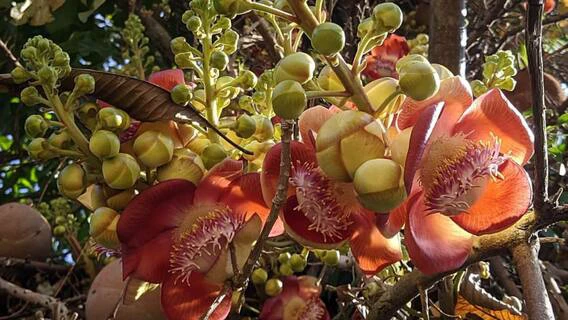During the spiritually charged month of Sawan, devotees all across the country turn to powerful symbols of Lord Shiv present in nature.
One such symbol is the Nagalingam flower. This bloom is so mystical that it’s said to represent both Shivling and the serpent Vasuki. With its cobra hood like petals encircling a Shivlingam shaped centre, this unique flower holds deep religious and botanical significance.
Here’s everything you need to know about this divine flower that has become a rare spiritual icon.
What Is The Nagalingam Flower?
Also known as the Cannonball flower, the Nagalingam is an exotic bloom that visually mimics a Shivling sheltered y a serpent’s hood, making it a natural symbol of Lord Shiv and Vasuki Naag. This resemblance has led many to believe it holds divine blessings, especially when found blooming in temple courtyards.
This large tree has hanging branches and round cannonball-shaped fruits. But it’s the rare and sacred flower, blooming directly from the trunk that captures spiritual attention.
Where Is It Found In India?
Though originally native to South America, the sacred Nagalingam tree has found a spiritual home on India. It’s widely revered and cultivated in South Indian states like Tamil Nadu, Kerala, Karnataka, Andhra Pradesh, and Telangana, where it is often planted near Shiv temples. In Eastern India, this tree can be spotted in Odisham West Bengal, Bihar, Jharkahhand, and Chhattisgarh. Most commonly, the Nagalingam tree thrives within temple premises, especially those dedicated to Lord Shiv, making it a spiritually significant and visually striking presence across several Indian states during the holy month of Sawan.
Does It Have Any Health Benefits?
While the Nagalingam flower is primarily revered for its spiritual and symbolic significance, certain parts of the Cannonball Tree have been used in traditional medicine across various cultures. According to some Ayurvedic and folk traditions, the bark and leaves of this tree are believed to offer anti-inflammatory and antimicrobial benefits. A herbal paste prepared from the leaves is sometimes applied externally to promote wound healing and relieve skin irritation.
In various practices, the extracts from the Nagalingam tree are occasionally used to ease symptoms of arthritis and rheumatism. Some formulations derived from the tree are also believed to support respiratory health and digestion, although modern scientific validation remains limited.
The rare sight of the Nagalingam flower during this holy month of Sawan is believed to be a sign of divine blessings. It serves as a reminder of the ever present connection between nature and the divine in Indian spirituality.
